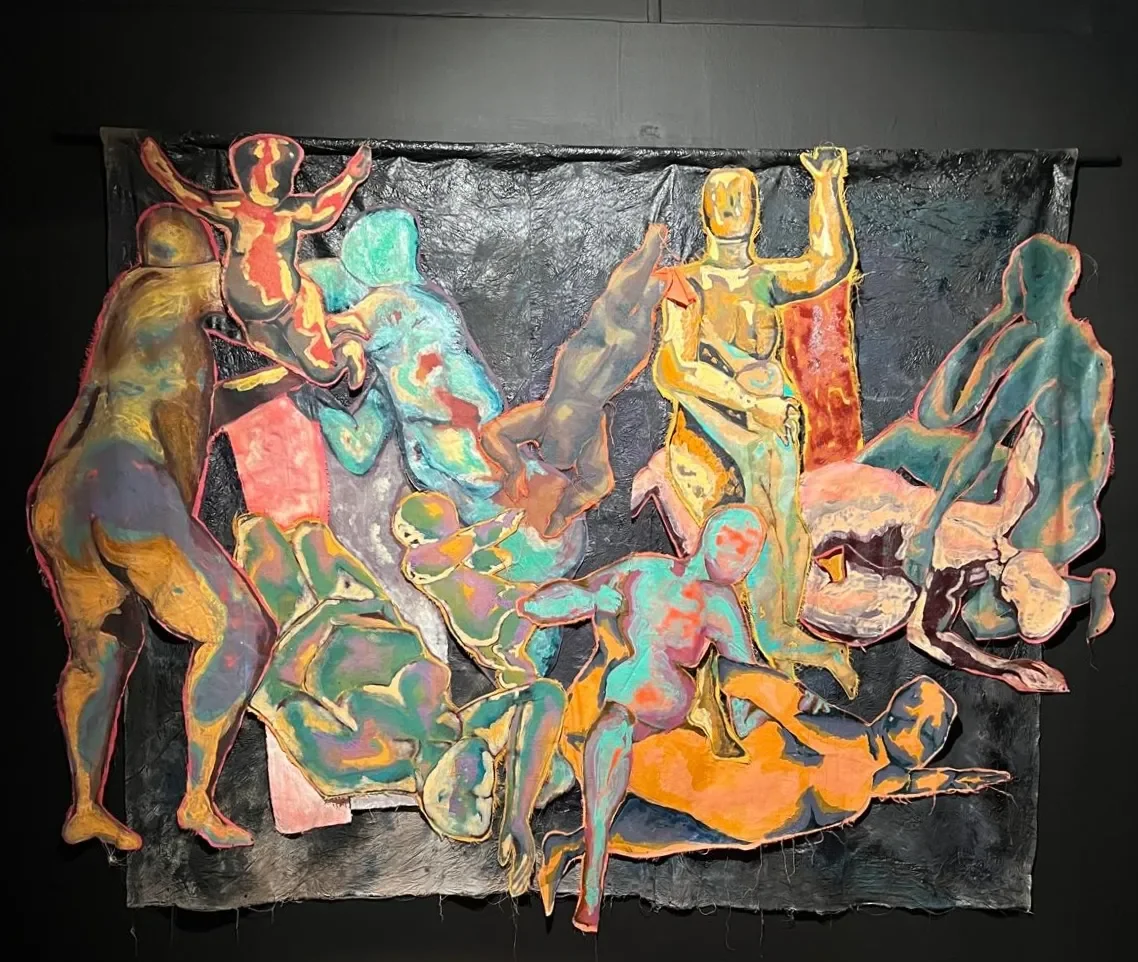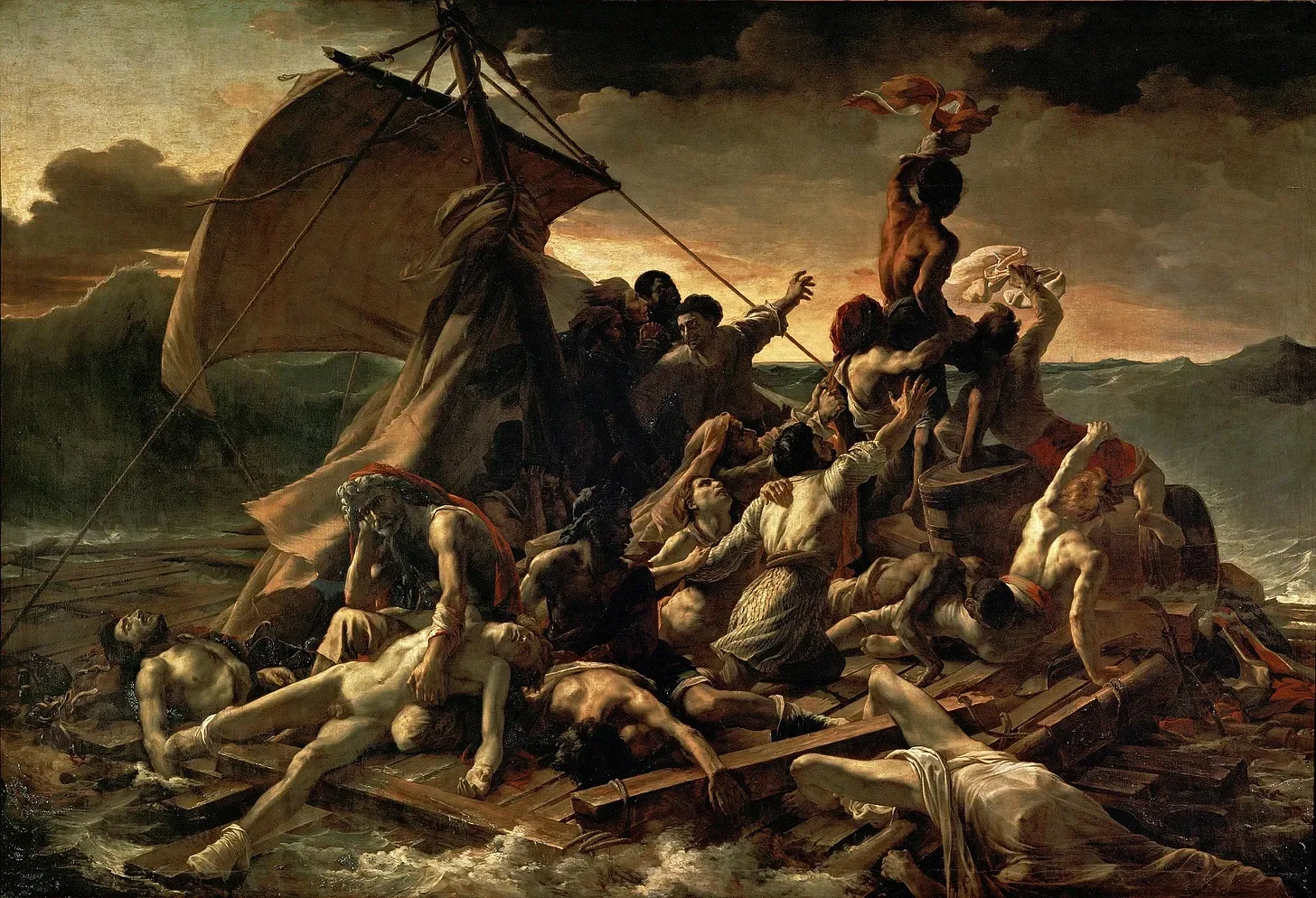Into the Void:
Reclaiming Creativity Through KindnessExplorations of No. 19- "The Raft Of The Medusa"
No. 19 “The Raft of The Medusa” at The National Art Gallery of The Bahamas.
The Bahamas has long been marketed as a utopia — pink sand beaches, swimming pigs, and smiling Black faces welcoming tourists into an idyllic fantasy. But beneath this carefully constructed veneer lies a harsher reality, one that remains obscured by the romanticised image of paradise. Life here can be profoundly difficult, particularly for those who exist on the margins of society — women, queer individuals, the disabled, and even Black people within a predominantly Black nation. This tension, though often muted by the allure of tourism, permeates the creative industry and has shaped my lived experience as an artist.
As a Black Caribbean female artist, I have felt this weight acutely. My journey in the creative realm, a passion nurtured since childhood, has been both rewarding and brutal. I recall spending countless hours captivated by shows like That’s So Raven and playing dress-up on the Bratz website, declaring, “I have a passion for fashion” as my mantra. My love for the arts blossomed alongside my mother, who embodied creativity in every sense. She built a chair, painting it my favourite colour — pink — and inscribed my name in vibrant green. At just four years old, I would eagerly accompany her outside, laying on a blanket to watch her work, absorbing every moment of her artistic process. With her background in fashion design and fine art, it felt as though I was genetically predisposed to follow this path. But what I have learned since then is that sustaining a career in the creative world is far from idyllic. It is a space that demands resilience, especially for those of us who are already fighting against systemic exclusion.
March of this year marked the opening of the 11th National Exhibition, titled NELEVEN: Into the Void, at the National Art Gallery of The Bahamas. My contribution to the exhibition is a reimagining of The Raft of the Medusa, a Romantic painting by Théodore Géricault that captured the desperation of shipwrecked individuals abandoned by their government. The most striking figure in the painting is a Black man clutching a red cloth, frantically signalling for rescue while an old white man sits at the bottom of the composition, clinging to the remains of what is believed to be his son. Géricault painted this work in 1819, a time when French society was still scarred by colonialism, slavery, and vast social inequities.
The imagery in The Raft of the Medusa spoke to me not only as a metaphor for societal collapse but as a reflection of what it means to exist as a creative in a space that thrives on exclusion. My own piece, No. 19 uses this historical reference that can speak to the condition of marginalised artists in the contemporary creative industry. The Black man waving the red cloth became a symbol of my own fight for visibility. I chose to further parallel this by painting a baby drenched in red in my own work, mirroring the desperation of the Black man clutching the cloth — a cry for help that remains ignored. The baby signifies the new generation of creatives who are born into a cycle of exclusion, forced to navigate a system that was not designed for them to succeed- A Void.
The Raft of the Medusa- Théodore Géricault
I have lived this firsthand. When I secured my first major opportunity within the creative industry, I was met not with mentorship or support, but with deliberate sabotage. A superior who perceived me as a threat worked to isolate me, block my progress, and diminish my voice. I would later watch my ideas be subtly co-opted and credited to others. The isolation I experienced led me into a void of self-doubt, forcing me to question my value, my voice, and my purpose. The parallels between my experience and the desperate cries for rescue depicted in The Raft of the Medusa were painfully clear.
What I have since realised is that the creative world behaves much like an addict. It is addicted to novelty, disruption, and aesthetics — but only when it is advantageous to the system. When emerging artists of colour enter these spaces, they are often perceived as commodities rather than equals. There is an unspoken understanding that their success must be limited so that the dominant power structure remains intact. This scarcity mindset breeds cruelty — acts of professional isolation, exclusion from critical networking circles, and the erasure of creative labour. I have seen firsthand how talent and innovation are weaponised against marginalised artists, who are made to feel like intruders in a world that feeds off their contributions.
But cruelty, as I have learned, does not have to be the standard. In my darkest moments — when I felt that the void would consume me — I realised that the antidote to exclusion is kindness. I took stock of my capabilities: I can paint, I can communicate, I can design. More importantly, I can build a community around me rooted in care, collaboration, and shared resilience. My slow emergence from the void was not the result of industry validation but rather the kindness extended to me by friends, collaborators, and strangers who believed in my work when I no longer did.
This is why I now approach my creative practice with the intention of kindness — not simply as a moral virtue but as a radical tool for dismantling exclusion. The scarcity mindset tells us that there is not enough space for all of us. But I reject that premise. There is room — and abundance — when we choose to uplift one another rather than hoard opportunity. I have learned that creative success should not be measured by proximity to power but by the impact we have on those around us. Every time we choose kindness over competition, we loosen the grip of the void and reclaim space for ourselves and others.
The figure in The Raft of the Medusa still resonates with me. His arm, raised high, waving the red cloth in a desperate bid for rescue, now feels symbolic of every marginalised creative fighting to be seen. The baby painted in red in my work serves as a haunting reminder of the future we condemn if we do not break this cycle. But the lesson I carry is this: we do not have to wait for a ship to rescue us. We can build rafts for each other. We can extend our own hands and pull one another out of the void. We can create new models of creative success that prioritise care, community, and collective survival.
As I continue my work, I hold tight to this ethos. My contribution to NELEVEN: Into the Void is not just a visual critique — it is a commitment. It is a declaration that kindness, in the face of exclusion, is revolutionary. And it is my belief that if we continue to practice kindness, we will not only survive the void — we will dismantle it entirely.
KENECHI


